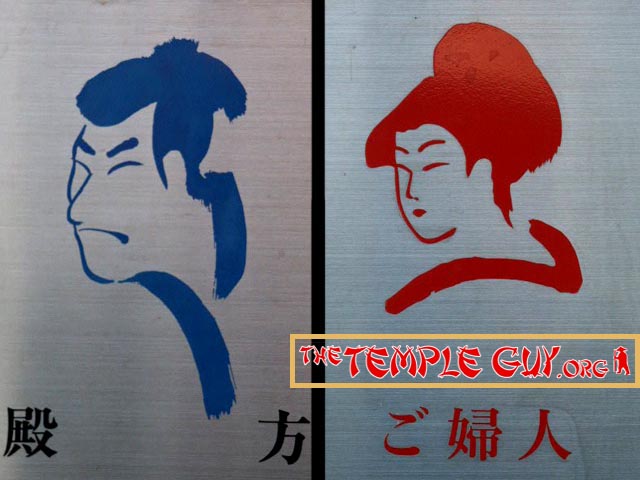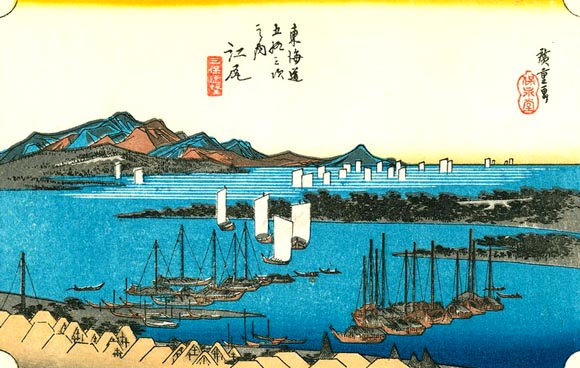Wednesday, September 19th, 2001 (click to see all posts from this day)
|
Preliminaries
This morning I said goodbye to the Maruyamas and they took me back to Higashi Shizuoka station. I stashed my bag at Shizuoka station, returned to Yui, and caught a cab to last night's stopping point. (There is no bus, as I discovered last night!)
Last night as I walked toward the base of Satta Pass I was regretting the darkness. This stretch of road looks more like the Tokaido of imagination than anything I had seen so far. So it was with real pleasure that I walked back a few hundred meters and took the pictures shown here.
Satta Pass and Yui, Station #16 on the Old Tokaido
The road to the Pass begins steeply, but levels out and becomes a beautiful walk before long. That's an ichirizuka marker on the right, just where the slope begins in earnest.
Yesterday I wrote that there were five Tokaidos. From here I could see four of them. (The shinkansen is inland and underground in a series of tunnels at this point.) The black arrows indicate (from left to right):
- The "New Tokaido" Highway 1 (expressway)
- Old Highway 1
- The Tokaido Honsen train line (only the electrical wires--not the tracks--are visible here)
- The Old Tokaido--on which I'm standing as I take the shot!
Satta Pass is well-known for what a dangerous, scary crossing it was. Exaggeration. These days it is being worked, mostly for citrus. Somebody--hikers?--stacked this fallen fruit on one portion of the walk.
Hiroshige's Tokaido: Yui, Station #16 on the Old Tokaido
[Note: Hiroshige used Satta Pass as his scene for Yui. Although I was in the station of Yui yesterday, I didn't reach the pass until today. So I have given Hiroshige's illustration twice: once yesterday, and again today.] Ladies and gentlemen, Hiroshige is a big fat liar. There is nothing like this on Satta Pass, his illustration for Yui. It's steep, yes, but not that steep. Anyway, the standard interpretation of it as dangerous and scary is exaggerated, at least as regards the modern Old Tokaido. |
Here is my example of a very famous view. The only problem is, the star of the show is missing.
As you can see from Hiroshige's print above, and this shot of the signboard along the way, you should be able to see Mount Fuji over the lower mountain in the distance. Not today.
from Satta TogeShizuoka Prefecture has really promoted the Old Tokaido. Even the signs along the way pay respect to the past.
I looked back and saw Fuji
or was it a cloud?
This slide warning sign features a man in old-fashioned dress. (Or does this sign mean, "It's dangerous to throw rocks at a samurai"?)
These two signs are on the restrooms at the beginning of the hiking trail (described below).
Near the top of the pass, a well-maintained hiking trail leaves the vehicle road and strikes off through the citrus groves. Here is the marker for the pass.
I wouldn't exactly call this part of the hike strenuous. I met a group of about 10 senior citizens along the way. We had a nice chat; here they are heading away afterward, probably talking about the goofy gaijin.
If you know Japan, you know that vending machines are everywhere. Well, here's a "back country" vending machine!
The Haunts of Shimizu no Jirocho
After the Pass: At the crossing of the Okitsu River (depicted in Hiroshige's print below) I stopped at a shop called "Hashimotoya." The shopkeeper was a jolly guy. He told me a German about my size had stopped in yesterday, also walking the Old Tokaido. He said the guy looked a lot like me--except he was wearing normal clothes! The shopkeeper also explained that this area--along the road, next to the river--was the hangout of Shimizu no Jirocho.
The history of this area is dominated by the fact that Shizuoka was the childhood home--and deathplace--of Ieyasu, the first Tokugawa, who founded the Tokaido. (Maybe that's why the Prefecture promotes it so much.) We'll take a look at him tomorrow, when I actually walk through Shizuoka City. (Although I will mention him once more today.) But to me, Jirocho was a far more interesting character.
Sometimes called a "boss," he was a real-life godfather: a hero to some, a villain to others. True, he ran a "gang." But he also started Shimizu's first English class! And when former President Grant visited Japan--landing at Shimizu port--Jirocho was entrusted with the preparations (he ran the docks), even though he wasn't considered qualified to meet Grant personally.
He was quite a character, and is a perennial favorite in Japanese films. Unfortunately, I couldn't find much about him on the net in the way of biography. [2019: To this day, no decent, stable articles!]
Okitsu, Station #17 on the Old Tokaido
Hiroshige's Tokaido: Okitsu, Station #17 on the Old Tokaido
Hiroshige shows two sumo wrestler crossing the Okitsu River. Pity the bearers--and the horse! |
On to Okitsu. This is where it all began for me. Oliver Statler used to stay at an inn in Okitsu that had been a sub-honjin--an inn for those less than a daimyo. He was inspired to write a book called Japanese Inn, which tells 400 years of Japan's history from the perspective of this inn. The Tokaido played host to some of the most prominent figures and events of the time, and Statler fictionalizes the historic inn owners and their brushes with history. (In fact, the Japanese title is Tokaido no Yado--"Inn on the Tokaido.")
I read this book upon my arrival in Japan, and it fired me. By coincidence, one of my closest friends--Tomoko, with whose family I stayed yesterday--was from Shizuoka, near Okitsu. So in the spring of 1998 I visited here, and saw a lot of the sites mentioned by Statler. This only whetted my appetite. (Statler's other big book, Japanese Pilgrimage, is part of the inspiration for the Shikoku part of my trip. He has a lot to answer for.)
I haven't seen Statler's inn, which--according to Patrick Carey's Rediscovering the Old Tokaido--is now the offices of a company.
As for my experience of Okitsu as a Tokaido walker: The shuku (station) was a bit disappointing after the excellent scenes in Yui and Kambara. Just a few stone markers. But Okitsu has one real gem:
Seikenji
This area between the mountains and the sea was a natural location for one of the barrier stations, which was called the Seiken seki (seki means "barrier"). This establishment eventually gave rise to Seikenji. (The marker for the barrier is in the parking lot of the temple.)
I visited here on that 1998 trip and saw the interior of the rooms, including one where Tokugawa Ieyasu is supposed to have studied as a boy. Today I said your prayers here. It's another Rinzai (Myoshinji subsect) temple, with Shaka Nyorai as the main image.
The Gohyakku Rakkan (500 arhats) are a real treat. Enjoy the Words and Pictures.
Here is my official Okitsu shot, in front of the hall where I prayed at Seikenji.
Walking in to Shimizu, I saw this example of Pop art (!) along the way.
Ejiri, Station #18 on the Old Tokaido
Not much remains of Ejiri, the old station now within the city of Shimizu. My map showed the site of Ejiri Castle near the route of the Old Tokaido; all I could find was a shrine. Reasoning that it's the only "historic" thing in the area (the site of the castle is now an elementary school), I decided to do my "official shot" at the shrine. A bunch of high schoolers were hanging out there, so I did the picture with some of them (for a change).
Hiroshige's Tokaido: Ejiri, Station #18 on the Old Tokaido
This bay view shows a little spit with pine trees, called Miho no Matsubara. It's a truly beautiful place (I went there in '98) with a truly beautiful story. It's said that one day a fisherman found a gorgeous feathered robe hanging on a pine tree at Miho. An angel had gone in swimming, and had left her robe behind. When she came out of the water, he insisted that she dance for him (nude?) before he returned the robe. The beauty of this place makes one believe it's possible. |
Weird encounters: As I left the shrine I came to a new bridge (dated August of this year, and still not open to cars) that was decorated with one of Japan's "big three" supernatural creatures: the kappa, a kind of water spirit. (The other two commonly mention are oni, a demon, and tengu, a kind of mountain spirit. I'll tell you more about them if I meet any.)
The kappa's power comes from a reservoir of water on top of his head. If you can get him to bow, the water will spill out, and he will be powerless.
There are lots of kappa stories. He's kind of creepy, like Tolkien's Gollum. You can read more about the kappa.
I trudged on to Kusanagi station and caught the train to Shizuoka, where I'm staying in a ryokan tonight. Tomorrow: central Shizuoka and beyond.
| ← Previous Day | Back to Old Tokaido Guide | Next Day → |
Posted September 28, 2019



















No comments:
Post a Comment